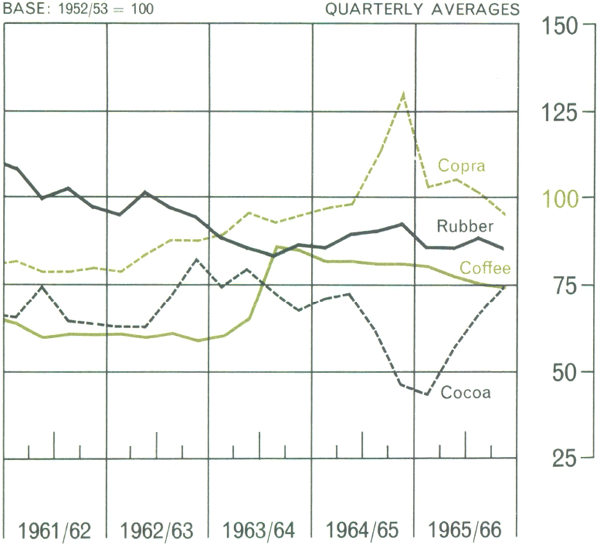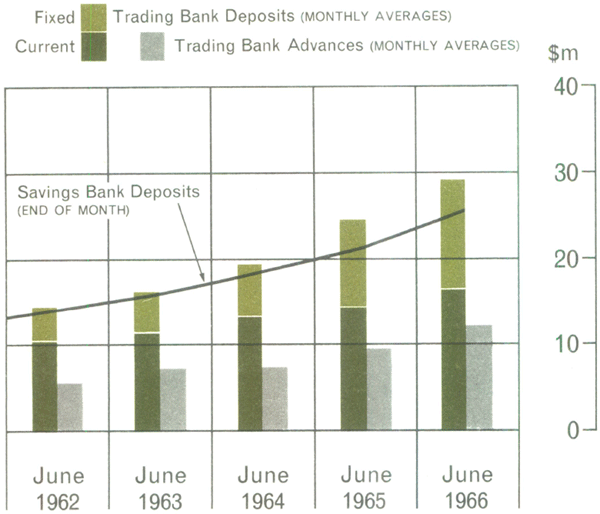Reserve Bank of Australia Annual Report – 1966 Papua and New Guinea
The central banking functions of the Bank extend to the Territory of Papua and New Guinea and its responsibilities there increase in importance with the development of the economy.
The Economy
During the past year some acceleration in the rate of economic expansion was achieved in both the public and private sectors of the Territory economy.
Government expenditure rose by 25 per cent to a record $132 million, of which about $90 million was financed by the Commonwealth Government. The annual non-repayable grant to the Territory Administration was $62 million, $6 million higher than in 1964/65; and about a further $28 million was spent directly in the Territory by Commonwealth departments, compared with $15 million in 1964/65. Most of this latter increase resulted from increased defence expenditure. The remaining $42 million was financed from internal current revenue of about $36 million, some $7 million higher than in 1964/65, and from domestic loan raisings of $6 million.
PAPUA AND NEW GUINEA
Price Indexes of Main Export Commodities

The large increase in Government expenditure was a major factor in stimulating activity in the private sector. Motor vehicle registrations continued to rise; building and construction, both residential and industrial, increased rapidly; consumer demand rose with the growth in the work force and the continuing expansion of the cash economy, into which more and more people are passing from the subsistence economy. Domestic prices increased significantly and the retail price index for June quarter, 1966, stood at 109.9 (Base: 1961/62= 100), compared with 103.8 a year earlier. The impetus in private investment was evidenced by an increased number of new company registrations and by negotiations to establish new industries.
The demand for imports strengthened and, in 1965/66, total imports were about 25 per cent higher than in 1964/65. The increase was accounted for mainly by larger imports of manufactures, machinery and transport equipment. Exports were little changed from the 1964/65 total of $49 million and the trade gap continued to widen.
Export volume generally increased but proceeds were affected by fluctuating world prices. Shipments of copra, the main export commodity, were larger but prices were below the record high levels of the second half of 1964/65. Cocoa prices, which had been depressed for some time, reached a trough at the beginning of the financial year but improved later. Increased coffee production more than offset the effects of lower prices and exports of some other important commodities also increased. The recently-introduced products, tea and pyrethrum, should boost future export income.
During the year steps were taken by the Administration to implement some of the recommendations of the Mission from the International Bank for Reconstruction and Development. An Economic Adviser to the Administration was appointed to co-ordinate economic development planning, and legislation was passed to establish a Papua and New Guinea Development Bank. The Development Bank will provide longer term credit to develop agricultural, industrial and commercial enterprises, particularly small-scale credit to promote indigenous enterprise.
Banking
Banking operations continued to expand during the year. Deposits with savings banks increased from $22 million to $26 million. A rise in deposits with the trading banks from $25 million to $29 million was reflected in both fixed and current deposits. Trading bank advances outstanding, which had totalled $10 million at the end of 1964/65, fell early in 1965/66 but later increased, to reach a total of $12 million in June, 1966.
Early in the year it was agreed with the banks that new bank lending in the Territory should not be restricted by any general limitations of lending policy current in Australia. Lending policies applied in the Territory would take specific account of Territory needs and conditions.
Papua and New Guinea, which uses Australian currency exclusively, made the change to dollars and cents on 14th February, 1966. Special problems were involved, particularly in areas outside the main centres. However, the changeover proceeded smoothly and the machinery conversion programme is expected to be completed early in 1966/67.
PAPUA AND NEW GUINEA/Banking

Reserve Bank Activities
The Bank's policy of encouraging participation by local people in the financial system has been taken a step further by the establishment of a Reserve Bank Advisory Committee in the Territory. The Committee's membership includes representatives of the Bank and the Territory Treasury, plus nine permanent residents of the Territory. Five of these are Papuans or New Guineans. The Committee will provide opportunities for discussion of local banking and financial matters.
The Savings and Loan Society movement entered another significant phase of its development during the year. Previously, all Societies had been individual entities linked only by their connection with the Registry of Savings and Loan Societies maintained by the Bank. However, a Federation of Savings and Loan Societies was formed in March on a Territory-wide basis to promote co-operation among societies for their common benefit. An important function initially is to conduct a contributory fund to be used to pay the outstanding balance of any loan due from a deceased borrower to a member Society.
Additionally, in the Rabaul area, the first League of Societies was formed. It has assumed responsibility for auditing the books of its member Societies and will also provide an advisory service on loans and other matters for its members. Similar Leagues should follow in other areas. Both the League and Federation employ their own staff and will meet their operating costs from members' contributions. These developments represent a further step in the assumption of responsibility for the promotion and servicing of Savings and Loan Societies by the Societies themselves.
Funds saved by members of Societies and the associated Savings Clubs reached $500,000 for the first time in February, 1966, and totalled $617,294 at the end of June. The following statistics show the accelerated rate of growth that has taken place:—
| Savings and Loan Societies | June, 1964 | June, 1965 | June, 1966 |
|---|---|---|---|
| Number | 23 | 62 | 139 |
| Membership | 1,161 | 3,426 | 7,523 |
| Members' funds ($) | 48,058 | 163,422 | 392,507 |
| Loans outstanding ($) | 4,354 | 41,722 | 143,052 |
| Savings Clubs | |||
| Number | 111 | 254 | 346 |
| Membership | 5,156 | 11,138 | 14,783 |
| Members' funds ($) | 57,712 | 138,186 | 224,787 |
Loans made by Societies have expanded. In 1965/66, 1,357 loans were made for a total of $138,159, compared with 402 for $45,400 in 1964/65. Most loans approved since inception have been to purchase building materials or for trading purposes. However, a significant amount has also been lent for the purchase of motor vehicles, accounting for 29 per cent of total loans made.
Through its Rural Credits Department the Bank has directly assisted with advances for the marketing of copra since 1952. Other Territory products eligible for Rural Credits Department finance include coffee, cocoa, peanuts, tea and timber.
The Bank continued its activities in financial education during the year. A further booklet entitled “Banks and Banking” was issued in the series prepared on financial topics. In all, about 100,000 copies of the English language editions of the five titles issued have been circulated in the Territory, mainly to schools and teacher-training establishments. In addition, 4,000 copies in Melanesian Pidgin and 3,000 in Police Motu, the two main lingua franca, have been distributed to adult groups.
The indigenous component of the Bank's Territory staff continues to grow and, at 30th June, 1966, comprised more than two-thirds of the total. This proportion should increase further as local staff rise to positions of higher responsibility.
The first essay at joint-bank staff training in Papua and New Guinea took place during the year. Two residential courses were conducted for indigenous staff from all banks in the Territory. Following their success, a Papua and New Guinea Bankers' College is being planned. This will be experimental initially, and will investigate correspondence and other courses suited to the needs of Papuan and New Guinean bank officers.
The Bank is also pursuing its own in-training programme for its indigenous staff.
Further scholarships were given to assist Papuan and New Guinean students to complete secondary and tertiary studies in Australia. Four students are currently at secondary schools in Sydney and one in Canberra under Bank sponsorship. In addition, two New Guinean students hold Bank bursaries for full-time study at Australian universities. The holder of the Bank's first University scholarship for a New Guinean student graduated Bachelor of Economics from Sydney University in April, 1966, and is now employed as a research officer in the Bank's Papua and New Guinea Division at Port Moresby.